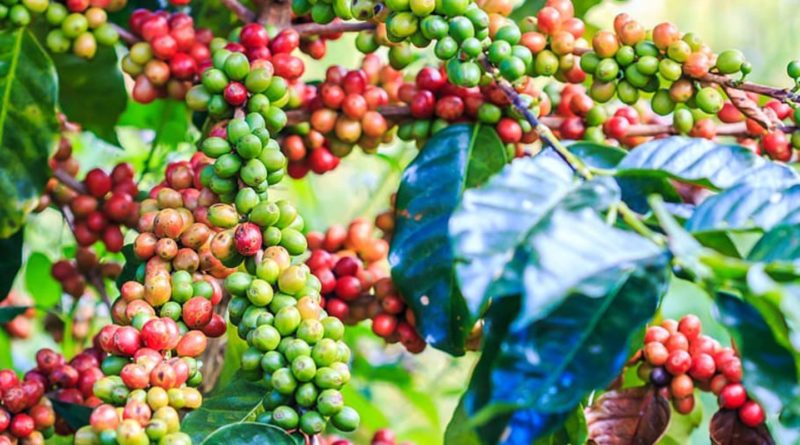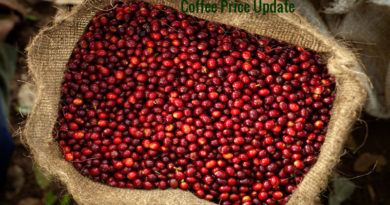ARABICA – Cultural operations to be carried out during June-July months
Cultural operations to be carried out during June-July months
1.DADAP PLANTING
Temporary shade i.e. lower canopy shade (Dadap) is very important for coffee during the drought period. These shade trees protect the coffee plants from bright sunshine during the summer heat. It is very essential to provide adequate shade to coffee plants during summer period by proper maintenance of both temporary and permanent shade trees. Dadap plants are grown to provide lower tier shade to coffee plants in coffee estates. The dadap stakes should be planted in the coffee fields during June- July months as sufficient moisture is present in the soil during these months which helps in early rooting of the stakes. However, in marginal areas where soil is gravel and soil moisture is deficient, the dadap plants do not root easily. In such cases, after planting dadap plants, the planting pits have to be treated with 1-2 litres of hormonal solution (1 ml of hormonal in 1 lit of water) which helps in early rooting of dadap plants. Use dadap stakes of 1-1.5 metre height and a minimum of 5-6 cm girth for planting. After one month of planting apply 25 gm of super phosphate to each plant for better development of roots and growth of the dadap plants.
2. SHADE TREE PLANTING
June-July months are ideal for planting shade trees. It is always better to have mixed shade trees rather than having mono shade like silver. Planting only silver oak trees does not ensure filtered shade. The temperature of the field is generally higher in the estates where silver oaks are planted as shade trees. Further, the silver oak leaf litter does not degrade as quickly as other leaves. The black rot disease and white stem borer incidence are more prevalent in estates with silver oak as shade tree. Therefore, it recommended that in coffee estates more of other shade trees have to be planted like Indian fig, atti, bili basari, mallegargatti, rose wood, jack, gandagarige and trees belonging to leguminous family. In high rainfall areas, the plants which shed leaves during the monsoon but quickly foliate after the monsoon have to be chosen. The trees like Atti or Balanji belong to this category. Planting of trees like neeli in the estates should be avoided as these trees harbour caterpillars. Permanent shade trees should be planted at a distance of 12-15 metres. In wind prone areas, silver oak and silk cotton trees have to be planted densely round the boundary of the estate.
3. COFFEE PLANTING
Undesired and suspicious coffee seedlings should be removed from the nursery and destroyed. Only healthy disease free and more vigorous seedlings of the desired variety should be selected from the nursery for planting in the field. Sixteen to eighteen months (root plants) old seedlings can be planted during June-July months in the planting pits opened earlier. At the time of planting, a hole should be made in the centre of the pit after levelling the soil and seedlings are planted in these holes. Add 5 gms of thimmet or forate crystals to the pit before planting the seedlings to avoid cockchafer problems.The tap root and the lateral roots are to be spread out in proper position beforepacking with the soil. In the case of ball plants, the polythene bag is cut at the bottom and tip of the tap root is nipped if it is found bent. Care should be taken so that soil around the seedlings is packed slightly above the ground level (one inch) to prevent water stagnation around the collar region of the seedlings. Avoid deep planting. Care should be taken to see that the planting pits should not contain gravel or stones at the bottom so that formation of bent root can be prevented. The planted seedlings are then provided with cross-stakes to prevent wind damage and mulched with dry leaves.
4. HANDLING AND CENTRING
Pruned plants start producing more and more new shoots after the receipt of sufficient showers. This necessitates one or two rounds of handling once during June-
July months and later during August-September. During the handling operation, the new flush arising after the main pruning is thinned out to a desired number (2 per
node) of well spaced branches. Centring should be done by the removal of new shoots arising within half foot radius of the main stem. This facilitates good air circulation and penetration of light into all parts of the plant as well as prevents the black rot disease. Centering is a skilled work; too much opening of the centre of the plants may invite trouble from White Stem Borer. Desuckering has to be done by removing the suckers growing from the mainstem. Gourmandizers should not be retained. There is a practice in some estates allowing the gourmandizers for many years. This practice should be discontinued as it spoils the plant frame work and all the lower branches will be affected in due course. All the criss-cross branches should also be removed. By removing all such undesired growth, the fertilizer use efficiency by the plants can be increased.
5. BLACK ROT MANAGEMENT
Continuous rain without a dry spell, saturated atmosphere with 80-100% relative humidity, breeze, thick overhead shade and hanging mist during the monsoon period causes the outbreak and spread of Black rot disease. This disease is more prevalent in valleys and in the estates with full of silver oak shade trees. The black rot pathogen infests leaves, developing berries and young shoots. Diseased leaves, berries and shoots turn black, start rotting and fall. On green berries the characteristic blackening starts from a side and spreads gradually in a narrow band. If this disease is not controlled, it is potential enough to cause 10-20% crop loss. In the areas prone to black rot disease, thinning of the overhead shade should be done before the onset of monsoon. Centering and handling of the bushes by removing criss-cross branches, dead and dry branches, suckers and dried fallen leaves of the shade trees on the canopy of coffee plants should be meticulously attended and removed. As soon as the symptom of the disease is noticed, all the affected leaves and berries should be removed and destroyed. In affected areas spray 1% Bordeaux mixture on both the surfaces of leaves and to the developing berries just before the onset of monsoon and during the break in the monsoon. Affected areas can also be sprayed with Bavistin 50 WP @0.03% a.i (120 gms in 1 barrel of water) just before the monsoon and also during the break in the monsoon period. Do not spray Bavistin during the rain.
6. WEEDING
If the growth of the weeds is seen, slash weed them
7. NURSERY
Remove the overhead pendal completely. Provide adequate drainage in the nursery so that rain water does not stagnate. All the weeds in the nursery has be cleared.
This article is part of “Coffee Kaipidi” published by
Director of Research
Central Coffee Research Institute
Coffee Research Station-577117
Chikmagalur District
Karnataka,India


